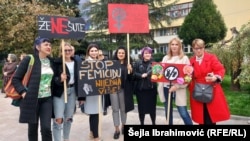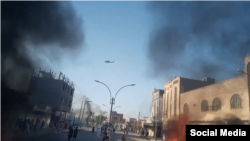As scattered anti-government and anti-hijab protests continue across Iran, members of one beleaguered ethnic and religious minority who joined in the demonstrations are still assessing the toll from "Bloody Friday."
Zahedan, the capital of the southeastern province of Sistan-Baluchistan, was the scene of the violent crackdown carried out by security forces on September 30 that observers say left more than 90 people dead -- and possibly scores more.
The victims were overwhelmingly Baluchis -- a mostly Sunni ethnic group that makes up the majority in the impoverished region, and who have long faced disproportionate discrimination at the hands of the Iranian authorities.
Rape Allegation Sparks Protests
Demonstrations have taken place in cities and towns across Shi’a-majority Iran since the death of 22-year-old Mahsa Amini, an Iranian Kurd who was detained on September 13 by the morality police for allegedly violating the country’s hijab law. She died three days later.
But in Sistan-Baluchistan, public anger at the authorities was raised further by reports that a 15-year-old Baluch girl had been raped by a police official in the province's southern port city of Chabahar.
After the rape accusation was aired publicly last month by Molavi Abdul Ghaffar Naqshbandi, the interim Friday Prayers leader in Rask, protests spread from that city about 170 kilometers north of Chabahar all the way to the regional capital.
The scene for protest was set when worshipers gathered on September 30 at the Great Mosalla of Zahedan, a prayer site near the city's central mosque that right groups say was targeted in the bloody crackdown.
During his Friday Prayers sermon, influential Sunni cleric Mawlana Abdolhamid Ismaeelzahi said that the "demands of the people should not go unanswered" and called for "serious measures to be taken" to investigate the alleged rape.
Chaos ensued. According to rights groups, including Amnesty International, a crowd assembled in front of a police station across the road to protest. Images on social media appeared to show some members of the crowd chanting anti-government slogans and some throwing rocks.
Security forces responded with deadly force by firing on the crowd from the station, according to Ismaeelzahi, who alleged in a video message on October 2 that pre-positioned plainclothes police used live rounds and aimed at the heads and hearts of protesters.
Videos on social media also appear to show the scenes inside the mosque as people prayed when security forces arrived. Many of the dead were reportedly killed outside the mosque, and security forces allegedly fired tear gas into the mosque's women's section.
People returning from Friday Prayers were also fired upon by snipers positioned on rooftops, according to Amnesty International and groups such as the British-based Baluch Activists Campaign (BAC), which has posted videos purportedly showing violent police action well into the night.
Blackout In Effect
Details of what happened have been difficult to determine, in part due to an Internet blackout in Zahedan that went into effect during the September 30 clashes.
Despite the digital void, gruesome images of dead bodies have emerged on social media, supporting reports that men, women, and children as young as two years of age were killed and wounded.
Hundreds more, including minors, have been reportedly arrested as house searches continue, allegedly leading to more deaths and injuries.
"There are no exact statistics on the wounded, local sources say the number is more than 300 people," Baluch activist Farzin Kadkhodaee told RFE/RL's Radio Farda. "Many of the dead have not been taken to the morgue and we do not know where they are, and this is one of the reasons why verification becomes difficult."
According to the activist, security forces at hospitals have told those wounded in the crackdown that they must state their acceptance of the authorities' narrative before they can be treated. The government has blamed the violence on militant groups operating in the region.
Official Blame Game
Amnesty International, in an October 6 report, said that "in an attempt to absolve themselves of responsibility for the deaths, the authorities have shared false narratives blaming the deaths on 'terrorists,' 'rioters,' and 'separatists' who they claim were acting for foreign governments."
The rights watchdog also said that detainees alleged to have carried out attacks on security forces have been trotted out on television with bags over their heads, and forced to make self-incriminating statements about their involvement in the violence.
Iranian state media has also reportedly said that Ismaeelzahi has admitted the role of militants and foreign actors in the protests, a claim that the cleric later denied.
Tehran has specifically blamed the violence on Jaish al-Adl, a Sunni militant group that is recognized as a terrorist organization by both Iran and the United States and which has previously claimed deadly attacks in Sistan-Baluchistan targeting Iranian security forces.
Local and independent sources, including Ismaeelzahi and Naqshbandi, have rejected the authorities' claims of any Jaish al-Adl involvement.
The authorities have also reported a much smaller number of fatalities, announcing that only 19 people, including several members of the security forces, were killed.
In its latest report, the BAC placed the number of confirmed dead at 93, with 350 injured, contributing greatly to the at least 201 people killed nationwide since protests erupted after Amini's death in mid-September.
Other Baluch activist groups and political organizations have claimed that as many as 350 people were killed on September 30, which they have referred to as "Bloody Friday."
More than 50 anti-riot vehicles as well as officers have been transferred to Zahedan since then, according to Ismaeelzahi.
Media reports and activists have also said that the city is under strict lockdown, with groups of no more than two people allowed to be on the streets or to attend mosque services together.
Internet blackouts also continue, with the cybersecurity watchdog Netblocks saying they have observed disruptions in Iran as recently as October 12 while nationwide protests rage on.
Despite the restrictions, protests appeared to resume in Zahedan on October 14, with unverified videos on social media showing residents taking to the streets after Friday Prayers, some chanting for the demise of Iran's supreme leader, Ayatollah Ali Khamenei, and the country's Basij paramilitary forces.
A Beleaguered Minority
Rights groups have long accused Iran's clerical establishment of suppressing and discriminating against the Baluch people, along with Kurds, Arabs, and other ethnic minorities.
As evidence, critics often point to the disproportionate number of Baluchis who are subjected to capital punishment in Iran.
While Baluchis make up only about 5 percent of Iran's 84-million population, according to Amnesty International, they accounted for 21 percent of the executions carried out in the country in 2021 and 26 percent in the first half of 2022.
The figures have raised serious concerns among rights watchdogs that the executions are part of a broader effort to sow fear among members of the disadvantaged Sunni community.
Sistan-Baluchistan, which borders Afghanistan and Pakistan, is the most impoverished of Iran's 31 provinces. It is also considered the most arid area in Iran, which has been hard-hit by drought in recent years.
Written by RFE/RL correspondent Michael Scollon based on reporting by RFE/RL's Radio Farda.










